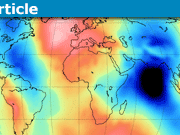All About the Einstein Field Equations
Table of Contents
Definition/Summary
The Einstein Field Equations (EFE) are a set of ten interrelated differential equations that form the core of Einstein’s general theory of relativity. These equations describe how matter and energy determine the curvature of spacetime, providing a mathematical framework to relate spacetime geometry to its energy-matter content.
Mathematically, the EFE relate the Ricci curvature tensor [itex]R_{\mu\nu}[/itex], the metric tensor [itex]g_{\mu\nu}[/itex], and the stress-energy tensor [itex]T_{\mu\nu}[/itex], incorporating the Einstein constant [itex]\frac{8\pi G}{c^4}[/itex].
Fast Facts
- Einstein’s Big Reveal: Albert Einstein first presented the Einstein Field Equations in 1915. Remarkably, they encapsulate the idea that spacetime is not a passive stage but interacts dynamically with energy and matter.
- 10 Equations in One: Although we talk about the EFE as a single equation, it’s actually a set of 10 coupled nonlinear partial differential equations. These describe how the geometry of spacetime relates to energy and momentum.
- Simpler in Symmetry: Many famous solutions, like the Schwarzschild solution (black holes) or Friedmann equations (cosmology), work because of simplifying symmetries in spacetime, reducing the problem from 10 equations to manageable ones.
- Tiny Numbers, Big Effects: The cosmological constant ([itex]\Lambda[/itex]) in the EFE, originally introduced by Einstein to allow for a static universe, is estimated at less than [itex]10^{-35} , \text{s}^{-2}[/itex]. It’s small but drives the accelerated expansion of the universe!
- Weak-Field Limit: The EFE include Newton’s law of gravity as a special case! In weak gravitational fields, the EFE reduce to the familiar [itex]\nabla^2 \Phi = 4\pi G \rho[/itex] from classical physics.
- Gravitational Waves: The EFE predict the existence of gravitational waves—ripples in spacetime caused by accelerating massive objects. These waves were directly detected in 2015, exactly 100 years after the EFE’s debut!
- Black Holes and Beyond: The Schwarzschild solution, one of the earliest solutions to the EFE, predicted black holes—objects so dense that not even light can escape their gravity.
- Equation with a Star Role: The EFE is so iconic that it’s often seen as the “face” of general relativity. It’s even been printed on T-shirts, mugs, and posters, becoming a symbol of modern physics.
- Supercomputing Required: Solving the EFE for realistic astrophysical scenarios, like binary black hole mergers, is so complex that it requires supercomputers and numerical relativity techniques.
- From Stars to the Universe: The EFE not only describe local phenomena like black holes and neutron stars but also the large-scale structure and evolution of the entire universe, forming the foundation of modern cosmology.
Equations
Short Version (using Einstein tensor:
[itex]G_{\mu\nu}[/itex])
[tex] G_{\mu\nu} = \frac{8\pi G}{c^4} T_{\mu\nu} [/tex]
Simplified in Cosmological Units
[itex]G = c = 1[/itex]
[tex] G_{\mu\nu} = 8\pi T_{\mu\nu} [/tex]
Long Version (using Ricci curvature tensor and scalar curvature)
[itex]R_{\mu\nu}[/itex] [itex]R = \text{Tr}(R_{\mu\nu})[/itex])
[tex] R_{\mu\nu} – \frac{1}{2} R g_{\mu\nu} = \frac{8\pi G}{c^4} T_{\mu\nu} [/tex]
Extended Explanation
Cosmological Units:
Cosmology frequently uses naturalized units where [itex]G = c = 1[/itex]. These units simplify the equations, making factors like [itex]\frac{8\pi G}{c^4}[/itex] reduce to [itex]8\pi[/itex].
Structure of the EFE:
- The EFE is a second-order, symmetric tensor equation, the simplest structure describing the relationship between spacetime curvature and energy-matter distribution.
- Tensors Involved:
- [itex]T_{\mu\nu}[/itex]: Stress-energy tensor describing energy, momentum, and stress.
- [itex]R_{\mu\nu}[/itex]: Ricci curvature tensor describing spacetime curvature.
- [itex]g_{\mu\nu}[/itex]: Metric tensor defining spacetime geometry.
- Scalars [itex]R[/itex] and [itex]T[/itex] (traces of [itex]R_{\mu\nu}[/itex] and [itex]T_{\mu\nu}[/itex]) are used as multipliers.
Cosmological Constant ([itex]\Lambda[/itex]):
The addition of a small multiple of [itex]g_{\mu\nu}[/itex], the cosmological constant [itex]\Lambda[/itex], allows the equations to describe the accelerated expansion of the universe. The modified EFE are: [tex] R_{\mu\nu} – \frac{1}{2} R g_{\mu\nu} + \Lambda g_{\mu\nu} = \frac{8\pi G}{c^4} T_{\mu\nu} [/tex]
Trace and Traceless Components:
A symmetric tensor can be decomposed into:
- Scalar Part (Trace): [tex] R = -8\pi T [/tex]
- Traceless Tensor Part: [tex] R_{\mu\nu} – \frac{1}{4} R g_{\mu\nu} = 8\pi \left( T_{\mu\nu} – \frac{1}{4} T g_{\mu\nu} \right) [/tex]
Reason for [itex]8\pi[/itex] Factor:
The factor [itex]8\pi[/itex] ensures consistency between the Einstein Field Equations and Newtonian gravity in the weak-field limit. In Newtonian gravity, the Poisson equation relates the gravitational potential [itex]\Phi[/itex] to the mass density [itex]\rho[/itex]: [tex] \nabla^2 \Phi = 4\pi G \rho [/tex] To recover this from the EFE, the Einstein tensor [itex]G_{\mu\nu}[/itex] must yield a comparable form. The factor [itex]8\pi[/itex] arises naturally to scale the stress-energy tensor [itex]T_{\mu\nu}[/itex] appropriately in relativistic contexts, maintaining compatibility with observed gravitational phenomena.
Key Insights:
- The EFE reduces to Newton’s law of gravity in the weak-field, low-velocity limit, providing a unifying framework for classical and relativistic gravity.
- Solutions to the EFE, such as Schwarzschild, Kerr, or Friedmann–Lemaître–Robertson–Walker metrics, describe black holes, rotating spacetimes, and cosmological models.
Non-standard Notation (“Notr”):
The notation “Notr” to indicate traceless parts of tensors is non-standard and might confuse readers. Common practice is to describe traceless components explicitly without introducing new notation.
I have a BS in Information Sciences from UW-Milwaukee. I’ve helped manage Physics Forums for over 22 years. I enjoy learning and discussing new scientific developments. STEM communication and policy are big interests as well. Currently a Sr. SEO Specialist at Shopify and writer at importsem.com










Leave a Reply
Want to join the discussion?Feel free to contribute!